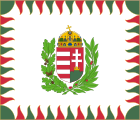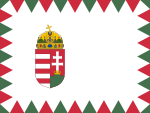Flag of Hungary
| Flag of Hungary | |
|---|---|
 |
|
| Vexillological symbol : |
|
| Aspect ratio: | 1: 2 |
| Officially accepted: | October 1, 1957 |
The flag of Hungary was officially adopted as the national flag on October 1, 1957 .
Description and meaning
The national flag of Hungary is a horizontal tricolor in red, white and green. A law of 1957 set a ratio of 2: 3 for the trade flag. In contrast, an ordinance of 2000 specifies an aspect ratio of 1: 2 for flagging government buildings. In the new constitution of April 25, 2011, a flag is shown in a ratio of 1: 2.
The vernacular assigns the following meaning to the three colors: Red stands for the blood that the Hungarians lost in numerous struggles for freedom and independence. White stands for the purity and cleanliness of the country. These two were the colors of the flag of the first Hungarians to settle in the Carpathian Basin - “ Árpád Stripes”. Green is the color of the 19th century revolution. According to another tradition, red means strength, white means loyalty, and green means hope. The fact that the flag of Tajikistan, introduced in 1992, has the same color sequence as the flag of Hungary is pure coincidence and not due to common roots. Tajikistan's choice of colors demonstrates more of the cultural proximity to Iran .
history
The Hungarian tricolor is derived from the historic coat of arms of Hungary , reintroduced in 1990 , which shows a silver patriarchal cross on a green hill with a red background. The use of the colors red, white and green dates back to the 9th century. They were used for the first time in 1608 during the reign of the Habsburg King Matthias II .
Tricolors with the colors red, white and green were in use in Hungary since the Napoleonic period - probably inspired by the French tricolor . The current form became official from 1848 to 1849 and again in 1867.
Because of the Hungarian Austro-compensation related from June 8, 1867 reorganization of the Empire of Austria to the new dual monarchy of Austria-Hungary was adopted its own flag for the Kingdom of Hungary, which contained the Hungarian colors in horizontal stripes arranged one above the other. The Hungarian colors were also used in the trade flag shared with the Austrian part of the empire.
With the end of Austria-Hungary in 1918 - Hungary had now become independent - a simplified new flag was also adopted: the red-white-green tricolor with the royal coat of arms of Hungary in the middle was retained, the angels on the left and right were omitted . After Hungary lost two-thirds of its national territory through the Treaty of Trianon in 1920 , all official flags in the country were lowered to half-mast . This expression of state mourning persisted until November 2, 1938, when Hungary got back the Hungarian-speaking border areas of southern Slovakia through the First Vienna Arbitration . Thereupon the flags were raised again by a third all over the country.
In 1944 the flag was changed slightly by removing the Stephanskrone from the coat of arms ( Kossuth coat of arms ).
In 1949 Hungary became a People's Republic , the previously used coat of arms in the center of the flag was replaced by a socialist coat of arms. Since the coat of arms was changed again in 1956, the simple tricolor was returned, which was derived from the royal coat of arms of Hungary.
 ? Flag of the Kingdom of Hungary December 21, 1867 - November 12, 1918
? Flag of the Kingdom of Hungary December 21, 1867 - November 12, 1918
 ? Trade flag of Austria-Hungary 1869–1918
? Trade flag of Austria-Hungary 1869–1918
 ? Flag of Hungary 1918-1919
? Flag of Hungary 1918-1919
 ? Flag of the Hungarian Soviet Republic, 1919
? Flag of the Hungarian Soviet Republic, 1919
 ? Flag of Hungary 1919–1946, aspect ratio 1: 2
? Flag of Hungary 1919–1946, aspect ratio 1: 2
 ? Flag of Hungary 1946 - August 19, 1949 and October 24, 1956 - September 30, 1957
? Flag of Hungary 1946 - August 19, 1949 and October 24, 1956 - September 30, 1957
 ? Flag of Hungary August 20, 1949 - October 23, 1956, aspect ratio 2: 3
? Flag of Hungary August 20, 1949 - October 23, 1956, aspect ratio 2: 3
 ? The symbol of the1956 Hungarian Uprising flagwith a cut-out coat of arms
? The symbol of the1956 Hungarian Uprising flagwith a cut-out coat of arms

 ? Flag of Hungary 1957–1989 (the depiction of this coat of arms in the flag was never official)
? Flag of Hungary 1957–1989 (the depiction of this coat of arms in the flag was never official)
 ? official version of the flag of Hungary from October 1, 1957
? official version of the flag of Hungary from October 1, 1957
More flags of Hungary
 ? Commercial flag
? Commercial flag
aspect ratio 2: 3 ? Land war flag
? Land war flag
aspect ratio 3: 4 ? Naval war flag
? Naval war flag
aspect ratio 3: 4
Web links
Individual evidence
- ^ Flags of the World
- ^ Flags of the World
- ↑ English translation of the Hungarian constitution from 2011 ( memento of the original from January 2, 2013 in the Internet Archive ) Info: The archive link was inserted automatically and has not yet been checked. Please check the original and archive link according to the instructions and then remove this notice. (PDF; 361 kB)













